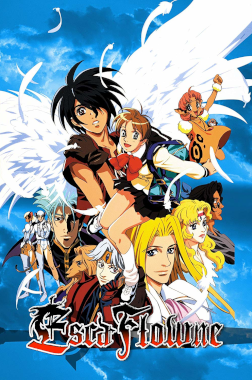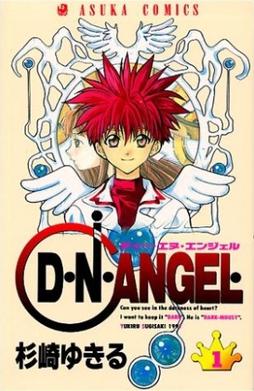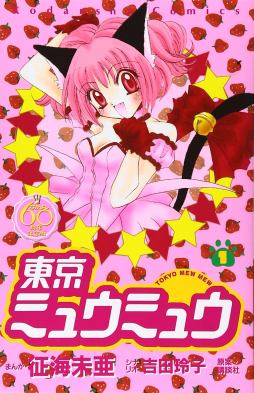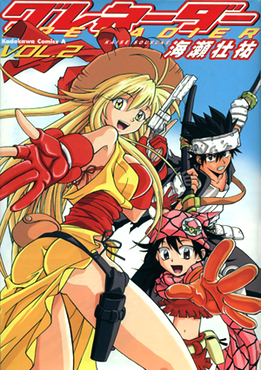
The Vision of Escaflowne is a Japanese anime television series created by Shōji Kawamori with Sunrise Studios and directed by Kazuki Akane. It premiered from April to September 1996, on TV Tokyo. Sony's anime satellite channel, Animax also aired the series, both in Japan and on its various worldwide networks, including Hong Kong, Taiwan, and Southeast Asia. It was licensed for Region 1 release by Bandai Entertainment.

Love Hina is a Japanese manga series written and illustrated by Ken Akamatsu. It was serialized in Kodansha's Weekly Shōnen Magazine from October 1998 to October 2001, with the chapters collected into 14 tankōbon volumes by Kodansha. The series tells the story of Keitarō Urashima and his attempts to find the girl with whom he made a childhood promise to enter the University of Tokyo. The manga was licensed for an English-language release in North America and the United Kingdom by Tokyopop, in Australia by Madman Entertainment, and in Singapore by Chuang Yi. Two novelizations of Love Hina, written by two anime series screenwriters, were also released in Japan by Kodansha. Both novels were later released in North America and the United Kingdom by Tokyopop.

Fruits Basket, sometimes abbreviated Furuba or Fruba (フルバ), is a Japanese manga series written and illustrated by Natsuki Takaya. It was serialized in the semi-monthly Japanese shōjo manga magazine Hana to Yume, published by Hakusensha, from 1998 to 2006. The series' title comes from the name of a popular game played in Japanese elementary schools, which is alluded to in the series.

Magic Knight Rayearth is a Japanese manga series created by CLAMP. Appearing as a serial in the manga magazine Nakayoshi from the November 1993 issue to the February 1995 issue, the chapters of Magic Knight Rayearth were collected into three bound volumes by Kodansha. They were published from July 1994 to March 1995. A sequel was serialized in the same manga magazine from the March 1995 issue to the April 1996 issue. It was published by Kodansha in three bound volumes from July 1995 to April 1996.

Great Teacher Onizuka, officially abbreviated as GTO, is a Japanese manga series written and illustrated by Tooru Fujisawa. It was originally serialized in Kodansha's shōnen manga magazine Weekly Shōnen Magazine from January 1997 to February 2002, with its chapters collected in 25 tankōbon volumes. The story focuses on 22-year-old ex-bōsōzoku member Eikichi Onizuka, who becomes a teacher at a private middle school, Holy Forest Academy, in Tokyo, Japan. It is a continuation of Fujisawa's earlier manga series Shonan Junai Gumi and Bad Company, both of which focus on the life of Onizuka before becoming a teacher.

Initial D is a Japanese street racing manga series written and illustrated by Shuichi Shigeno. It was serialized in Kodansha's seinen manga magazine Weekly Young Magazine from 1995 to 2013, with the chapters collected into 48 tankōbon volumes. The story focuses on the world of illegal Japanese street racing, where all the action is concentrated in the mountain passes and rarely in cities or urban areas, and with the drifting racing style emphasized in particular. Professional race car driver and pioneer of drifting Keiichi Tsuchiya helped with editorial supervision. The story is centered on the prefecture of Gunma, more specifically on several mountains in the Kantō region and in their surrounding cities and towns. Although some of the names of the locations the characters race in have been fictionalized, all of the locations in the series are based on actual locations in Japan.

D.N.Angel is a Japanese manga series written and illustrated by Yukiru Sugisaki. The manga premiered in Japan in the Kadokawa Shoten shōjo magazine Monthly Asuka in November 1997. After two extended hiatuses the series concluded in 2021. Kadokawa Shoten has collected the individual chapters and published them in 15 tankōbon and 5 e-books. The manga series is licensed for English language release in North America and the United Kingdom by Tokyopop, which has released 13 volumes of the series as of 2011.

Tokyo Mew Mew is a Japanese manga series created and written by Reiko Yoshida and illustrated by Mia Ikumi. It was originally serialized in Kodansha's shōjo manga magazine Nakayoshi from September 2000 to February 2003, with its chapters collected in seven tankōbon volumes by Kodansha. It focuses on five girls infused with the DNA of endangered animals which gives them special powers and allows them to transform into "Mew Mews". Led by Ichigo Momomiya, the girls protect Earth from aliens who wish to "reclaim" it.

Samurai Champloo is a 2004 Japanese historical adventure anime television series. The debut television production of studio Manglobe, the 26-episode series aired from May 2004 to March 2005. It was first partially broadcast on Fuji TV, then had a complete airing on Fuji Network System. It was licensed for North American broadcast on Adult Swim, and for commercial release first by Geneon Entertainment and later by Crunchyroll. It was also licensed for English releases in the United Kingdom by MVM Films, and in Australia and New Zealand by Madman Entertainment. A manga adaptation was serialized in Monthly Shōnen Ace during 2004, later released in North America by Tokyopop the following year.

The Twelve Kingdoms is a series of fantasy novels written by Japanese author Fuyumi Ono and illustrated by Akihiro Yamada. The first entry in the series called The Twelve Kingdoms: Sea of Shadow was published by Kodansha in Japan in 1992; the last Kodansha volume was released in 2001. In 2012, the series was resumed under the Shinchō Bunko line from Shinchosha. Shinchosha has also begun reprinting the older volumes with new cover and interior art from Akihiro Yamada. The first new publication of the series in six years was released in 2019.

Grenadier is a Japanese manga series written and illustrated by Sōsuke Kaise. It was serialized in Kadokawa Shoten's shōnen manga magazine Monthly Shōnen Ace from April 2002 to March 2005, with its chapters collected in seven tankōbon volumes. In North America, the manga was initially licensed by Tokyopop and released in print from 2006 to 2008. It was later licensed for digital release by Viz Media and released in 2015.

Pita-Ten is a Japanese manga by Koge-Donbo. It was serialized in the shōnen manga magazine Dengeki Comic Gao! between the October 1999 and August 2003 issues and was later collected into eight tankōbon volumes. The eight volumes were localized for North America by Tokyopop; Madman Entertainment used Tokyopop's translations for distribution in Australasia. The plot follows Kotarou Higuchi who becomes acquainted with the angel Misha, and the demon Shia.

Shonan Junai Gumi is a Japanese manga series written and illustrated by Tooru Fujisawa. It was published in Kodansha's Weekly Shōnen Magazine from October 1990 to October 1996, compiled in 31 tankōbon volumes. A 15-volume bunkoban edition was released from May to December 2005. The story follows the youth of Eikichi Onizuka and his best friend Ryuji Danma while they are still in high school but have already formed their shock duo the Oni-Baku Combi.

Chobits is a Japanese manga series written and illustrated by the Japanese manga collective Clamp. It was serialized in Kodansha's seinen manga magazine Weekly Young Magazine from September 2000 to October 2002, with its chapters collected in eight bound volumes. Chobits was adapted as a 26-episode-long anime television series broadcast on TBS from April to September 2002. In addition, it has spawned two video games as well as various merchandise such as model figures, collectible cards, calendars, and artbooks.

Deadman Wonderland is a Japanese manga series written and illustrated by Jinsei Kataoka and Kazuma Kondou. It was serialized in Kadokawa Shoten's Monthly Shōnen Ace from April 2007 to July 2013, with its chapters collected in 13 tankōbon volumes. Tokyopop acquired the licensing rights to distribute the manga in English and released the first five volumes before the company shut down its North American publishing division in 2011. The series was later licensed by Viz Media, who published the 13 volumes from February 2014 to February 2016.

The tenth season of the Bleach anime series, released on DVD as the Arrancar vs. Shinigami arc, is directed by Noriyuki Abe, and produced by TV Tokyo, Dentsu and Studio Pierrot. The season adapts Tite Kubo's Bleach manga series from the rest of the 32nd volume to the 35th volume, with the exception of episodes 204 and 205 (filler). The episodes' plot continues to follow Ichigo Kurosaki's and his friends' battle against the Espada, the strongest of former Soul Reaper Captain Sōsuke Aizen's army, to rescue Orihime Inoue.

The fourth season of the Black Clover anime television series was directed by Ayataka Tanemura and produced by Pierrot. The season premiered on December 8, 2020 on TV Tokyo in Japan, and ended on March 30, 2021. The season started with anime canon episodes supervised by author Yūki Tabata before continuing off with the 24th volume of his manga series of the same name starting on episode 158. Both Crunchyroll and Funimation licensed the series for an English release, with Crunchyroll simulcasting the fourth season, and Funimation producing a North American Simuldub.

Saiyuki Reload is a Japanese anime television series adapted from the manga of the same name by Kazuya Minekura. Produced by Studio Pierrot, the series is directed by Tetsuya Endo, written by Tetsuya Endo and composed by Daisuke Ikeda.

Saiyuki Reload Gunlock is a sequel and the third season of the Saiyuki anime television series produced by Studio Pierrot. Adapted from the manga of Saiyuki Reload by Kazuya Minekura, the series is directed by Tetsuya Endo, written by Tetsuya Endo and composed by Daisuke Ikeda.



















